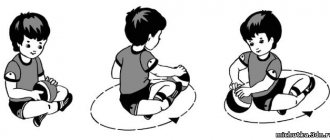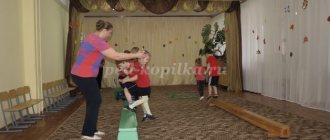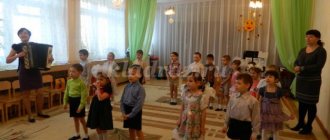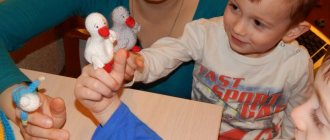Physical education classes: tasks, structure, types
Lyubov Fedorova
Physical education classes: tasks, structure, types
Physical education classes . Objectives , structure and types of classes . Ways to organize children.
Physical education classes are the main form of organized systematic teaching of physical exercises.
This form of work is leading for the formation of correct motor skills and abilities, creating favorable conditions:
• to master general provisions and patterns when performing physical exercises,
• promotes the development of children's versatile abilities.
Educational physical education classes simultaneously with all children make it possible to ensure conscious assimilation of the material, to lead children to generalizations related to the mastery of motor actions and their use. Without generalization, it is impossible to transfer correct execution to other situations.
Objectives of physical education classes:
1. classes allow you to teach preschoolers to independently create conditions for physical activity;
2. lead children to independently perform complex motor actions;
3. form and develop self-organization skills in the use of various movements and cultivate interest and desire for active actions, thereby providing the basis for interesting and meaningful activities in everyday life;
4. the more exciting and meaningful the activities , the richer the child’s motor experience, the more prerequisites for ensuring a high motor regime during the day, which is necessary to satisfy the growing body’s need for movement;
5. classes contribute to the development of learning activity skills in preschoolers:
o they teach children to remember the plan of action and be guided by it during physical exercises;
o develop value judgments in children: achieving good results in front of all children instills confidence in the child and creates a joyful mood, awareness of their abilities and capabilities in realizing common interests, and shared joy is double joy.
Successful solution of educational problems is possible only if the requirements for the health-improving orientation of physical education classes :
1. ensuring high physical activity of children;
2. compliance with scientifically based loads on all organs and systems of the child allows for an effect in his physical development and health promotion;
3. passing and mastering program material in a certain sequence;
4. repetition and consolidation, as necessary, of motor actions;
5. dosed physiological load, and its gradual increase, which helps to increase the body’s endurance;
6. preparing the body to perform complex movements, allowing to prevent injuries when performing them;
7. teaching children to listen to the teacher’s instructions;
8. performing movements simultaneously by the whole group, which forms their activity, fosters a conscious attitude towards the exercises being carried out, the ability to listen to the end and act in accordance with a given plan or creatively carry out proposed tasks .
Structure of physical education classes
In the manual by T. I. Osokina, a physical education lesson is three-part, consisting of an introductory, main (general developmental exercises, basic movements and outdoor game)
and the final part.
Let's look at the objectives and content of each part of the lesson . In the introductory session, as in other parts of the lesson tasks are solved first of all :
• learning drill exercises;
• mastering different ways of walking and running;
• consolidation of simple learned movements (jumps with forward movement on one and two legs)
;
• use of leading exercises for successful mastery of complex movements included in the lesson ;
• development of reaction speed and activation of children's attention;
• development of dynamic orientation in space;
• involvement of various organs and systems in an ever-increasing physiological load;
• warming up the foot and preventing flat feet.
In the main part, with the help of general developmental exercises, other tasks :
• the teacher must ensure the formation of correct posture;
• help prepare the child’s body for the load, in order to warm up various parts of the body with the help of certain exercises, which will prevent injuries and ensure the best result in performing the movement;
• use lead-in exercises to create conditions for successful mastery of the movements being learned.
Basic movements are included for initial learning, consolidation, improvement and ensuring sufficient physiological load for the development of certain physical qualities.
The final part provides for a transition from intense activity to calm activity, a reduction in physiological load, so that within 2-4 minutes after the lesson the child’s pulse returns to its original state. This is achieved by including sedentary games and walking at different paces.
The duration of all classes in the junior group is 5-20 minutes, in the middle group - 20-25 minutes, in the senior group - 25-30 minutes, in the preparatory group - up to 35 minutes.
Types of physical education activities
The types of physical education activities are characterized by great diversity.
I. By content:
1. gymnastics and outdoor games,
2. training in sports exercises and elements of sports games,
3. development of orientation;
4. hiking activities (elementary tourism)
.
II.On the use of working methods:
Mixed-type classes occupy a large place in kindergartens (when one lesson involves learning some exercises and consolidating and improving others);
2. game type of activities ;
3. plot type of classes ;
4. the lesson may also involve only consolidation and improvement of movements;
5. control type of classes (the teacher determines the level of mastery of the material for the quarter, half-year, year).
At the same time the structure of physical education classes does not change ; they differ in content objectives , selection of exercises and form of delivery.
Ways to organize children in class
The effectiveness of teaching physical exercises is ensured through various ways of organizing children. When performing movements, these methods influence the number of repetitions in the allotted time, provide teacher control over the process of mastering the material, create conditions for conscious mastery of the structural components of movement and allow children to learn not only from the teacher, but also from their peers.
In physical education classes, a frontal method of organization is used, in which all children simultaneously perform the same movement. This method allows, in the time allocated by the teacher, to ensure a sufficiently high repeatability, which contributes to the rapid formation of temporary connections, the achievement of high activity of each child and sufficient physical activity when performing any movement. But at the same time, the teacher cannot keep all the children in sight; switching to teaching some, he does not see the actions of others. Therefore, when a movement is repeated many times, the child may perform it incorrectly and subsequently will have to make corrections to it. The child does not have the opportunity to observe the actions of other students. This method is quite suitable for forming an initial idea of a new movement, for mastering the initial actions with some new aid (ball, hoop, bag, etc., when orientation in execution is created. For example, the frontal initial execution of crawling under a cord in the junior group, mastering purposeful actions with the ball, jumping in place, etc., throwing and catching the ball, rolling the ball to the opposite side, jumping rope (in the middle group)
etc. It is advisable to perform movements frontally not only at the stage of initial learning, but also at the stage of consolidation and improvement.
It should be borne in mind that the frontal method is applicable only to movements that do not require protection from injury, and is used in all parts of physical education classes .
To perform physical movements, students can be divided into groups, i.e., a group method of organizing children is used. At the same time, each group, as a rule, practices certain movements, so the number of children in one exercise is significantly reduced. After some time, the subgroups change places, and this allows you to move on to actions on different apparatus, which increases interest in the lesson . With this method, an opportunity is created for in-depth learning of movements by one subgroup, while other subgroups at this time perform mastered movements to consolidate them or in complicated conditions. The advantages of this method are the creation of favorable conditions for detailed assimilation: a small number of children allows for a sufficient number of repetitions for successful mastering the exercise, the child has the opportunity to hear the instructions of an adult relating to him and other children; a short break between repetitions, on the one hand, is sufficient to restore strength, and on the other hand, temporary connections are successfully formed and there are conditions for observing other children performing the exercise.
Children perform familiar physical exercises without the direct supervision of a teacher, which develops their independence in using learned movements, self-control and self-esteem. This movement is included in the child’s motor experience. The group method creates favorable conditions for learning the component elements of movement. However, if a new movement or method of performing it is learned during a lesson , then a movement that requires backup cannot be taken for consolidation.
A variation of this method is the shift method, when children perform one movement in shifts (3-4 people at the same time, balance exercise on four aids, jumping off a bench, etc.
The flow method involves performing physical exercises one after another, moving from one movement to another. At the same time, some children finish a movement and move on to the next one, while others are just starting to perform the first. This method ensures almost continuity of actions, develops the flexibility of skills in children, the ability to move directly to performing other movements, and develops the ability to combine movements. However, learning a new physical exercise using this method is difficult, since the muscle sensations that arose when performing this movement for the first time are then erased when performing familiar motor actions, and when approaching the reproduction of the learned movement again, the child makes mistakes. At the same time, he is deprived of the opportunity to learn from his peers, as he is busy performing his movement.
This method successfully solves the problems of consolidating and improving movements.
There is an individual way of organization, when children perform one movement in order of priority. In this case, it is easy for the teacher to assess the quality of each child’s movement and make individual instructions. At this time, other Children observe the actions of each person performing the exercise and perceive comments. An individual method provides a safety net to prevent injuries. At the same time, taking turns reduces children’s activity, monotony leads to monotony, and hence to children’s distraction from the learning process. Such an organization does not allow for a sufficient number of repetitions for assimilation, reduces the physiological load, and also creates a long break between repetitions.
Often, during a lesson resorts to a combination of these methods of organizing children when performing physical exercises. So, within the group method, some movements are carried out individually (running high jumps, somersaults, etc., and others - in shifts (pull-ups on a bench, balance exercises, crawling, etc.)
. A similar combination is used in the in-line method.
Stepanenkova E. Ya. Theory and methodology of physical education and child development: Textbook. aid for students higher textbook establishments / Emma Yakovlevna Stepanenkova. — 2nd ed., rev. — M.: Publishing House
, 2006. - 368 s.
The importance of physical education
The foundation of health is laid from preschool age. It is at this time that all organs and systems of the body actively develop. An integrated approach to physical development allows you to raise a healthy child. Therefore, the preschool institution carries out the whole range of health measures.
This includes a balanced diet, walks in the fresh air, a rational regimen, developing personal hygiene habits, good sleep, prevention of various diseases, hardening, and also physical education in kindergarten. The set of exercises performed in classes is aimed at a certain age.
Physical education in kindergarten helps to increase children's resistance to various diseases, activates the immune system and the body's defenses, and increases the action of leukocytes. And also there is a comprehensive development of mental abilities, attention, thinking, perception, temporal and spatial concepts. Physical culture helps improve the nutrition of body tissues, participates in the formation of the skeleton and its strength, and correct posture. We can say that movement, physical education in kindergarten and a healthy lifestyle are the key to children's health.
Standard sets of exercises
If a child constantly exercises, his appetite and activity increase throughout the day. All exercises are selected in such a way as to affect the muscles of the spine, neck, lower back, shoulders, limbs and pelvis. The main goal pursued by educators is to influence the strengthening of the musculoskeletal system, as well as the prevention of diseases such as scoliosis.
It is best to do exercises in the fresh air, which is what all educators try to do in the warm seasons, and in winter a ventilated room is well suited, usually a sports or music room. Gymnastics along with hardening have a very good effect on a child’s body. In the future, this has a positive effect on the baby’s immune system and resistance to many diseases.
The set of exercises includes three stages:
- introductory part. Exercises (rotations of the head, circular movements of the arms, turns of the torso, bending);
- basic exercises. Stretching the muscles of the arms, legs and back, squats with gradually increasing repetitions, push-ups (if possible);
- final part. Light jogging with a step, shaking the muscles to relax.
The first stage includes various types of walking, as well as running, which are necessary to gradually activate different muscle groups. Next, you can begin exercises that will help strengthen and strengthen muscles, as well as joint mobility, posture and coordination. As for the final part, this usually includes some types of gymnastics and moderate walking.





